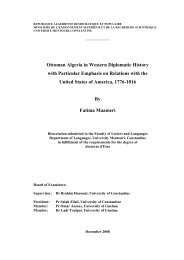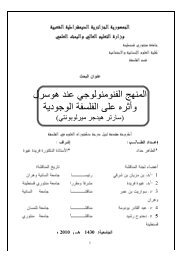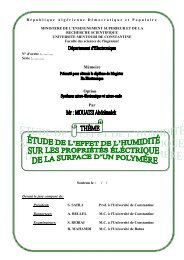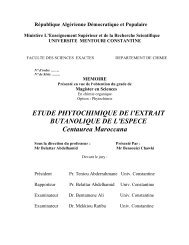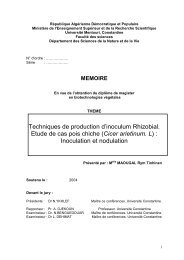- Page 1 and 2:
République Algérienne Démocratiq
- Page 3 and 4:
Remerciements: Il m'est très diffi
- Page 5 and 6:
I-1-6-7: Intérêt biologique du ge
- Page 7 and 8:
IV-2:Identification des produits is
- Page 9 and 10:
Introduction Générale: Les plante
- Page 11 and 12:
CHAPITRE I Le Matériel végétal
- Page 13 and 14:
- Fleurons périphériques ligulés
- Page 15 and 16:
Tableau I: Distribution des différ
- Page 17 and 18:
Cyanareae (50) Mutisieae (55) Lactu
- Page 19 and 20:
13 melitensine 14 11,13 dihydromél
- Page 21 and 22:
- Les anthocyanidines (ou anthocyan
- Page 23 and 24:
I-1-6-Le genre Achillea I-1-6-1-Des
- Page 25 and 26:
A.asplenifolia 8α-acétoxytannunol
- Page 27 and 28:
4-hydroxy-11-hydroperoxy-9-bisabole
- Page 29 and 30:
(13) 15 4 5 6 O OR 14a 14b 14c 14d
- Page 31 and 32:
OH OH 2 4 O OH OAng O 21 21a 21b 2
- Page 33 and 34:
Plus d'une centaine de composés ch
- Page 35 and 36:
[5] Simonpoli, P.1993.In Arburi, Ar
- Page 37:
Flavonoïds: old and new aspects of
- Page 40 and 41:
II-1-Introduction Les métabolites
- Page 42 and 43:
Aldéhydes: 3HC CH 3 CH 3 CHO H H C
- Page 44 and 45:
α- Thujène Thujone Sabinol Groupe
- Page 46 and 47:
3 4 5 CH 3 2 1 8 7 6 OH CH 3 H 3 C
- Page 48 and 49:
c- Triterpènes pentacycliques: Les
- Page 50 and 51:
R 12 11 17 C 13 1 D 16 2 9 10 3 A B
- Page 52 and 53:
CH 3 CH 3 CH 3 HO Démostérol 21 C
- Page 54 and 55:
dihydroflavonol (4), flavone (3) (i
- Page 56 and 57:
l'aulne, l'épicéa, le sapin, le s
- Page 58 and 59:
Schema II- 15: β-monoglyceride. O
- Page 61 and 62:
Références bibliographiques: [1]
- Page 63 and 64:
[25] J.F. Christopher and G.H.Neil-
- Page 65 and 66:
III-1:Etude bibliographique du genr
- Page 67 and 68:
Tableau III-1-a: Résultats de la s
- Page 69 and 70:
Tableau III-1-d: Résultat du fract
- Page 71 and 72:
Genre Espèce Ranunculus Cortusifol
- Page 73 and 74:
*Etude de la fraction F 3 : La frac
- Page 75 and 76:
Le tableau III-2-d: reporte les ré
- Page 77 and 78:
Poids : 34,4 mg 3 plaques préparat
- Page 79 and 80:
Les fractions présentant la même
- Page 81 and 82:
Tableau III-2-m: Résultats de la C
- Page 83 and 84:
Conclusion: Au cours de notre trava
- Page 85 and 86:
[13] Todorova,M.,Trendafilova,A.,Mi
- Page 87 and 88:
[38] Hiroyuki Minakata, Hajime Komu
- Page 89 and 90:
IV-1-1: Elucidation structurale du
- Page 91 and 92:
Spectre n°IV-1-1-2 : RMN 1 H (400M
- Page 93 and 94:
IV-1-2:Elucidation structurale du c
- Page 95 and 96:
Dans cette structure, il n' y a qu'
- Page 97 and 98:
Spectre n °IV-1-2-5 : Spectre COSY
- Page 99 and 100:
Spectre n°IV-1-2-4-b : Spectre HMB
- Page 101 and 102:
Spectre n°IV-1-3-3 : Spectre RMN 1
- Page 103 and 104:
Spectre n° IV-1-3-4:Spectre HSQC (
- Page 105 and 106:
IV-1-4 : Elucidation structurale du
- Page 107 and 108:
Spectre n°IV-1-3 -2: Spectre COSY
- Page 109 and 110:
Spectre n°IV-1-3 -3-b : Spectre HS
- Page 111 and 112:
Tableau IV-1-3-b: Données de la RM
- Page 113 and 114:
Spectre n°IV-1-5 -2 : Spectre SMIE
- Page 115 and 116:
Tableau IV-1-6-2: données RMN 'H d
- Page 117 and 118:
IV-1-7: Elucidation structurale du
- Page 119 and 120:
méthyle. Ce proton éthylénique m
- Page 121 and 122:
IV-1-8: Elucidation structurale du
- Page 123 and 124:
La localisation de C-1' à δ=122,5
- Page 125 and 126:
Tableau n° (IV-1-8-1) : données d
- Page 127 and 128:
pour OH-10, et une orientation- pou
- Page 129 and 130:
Figure 1: Corrélations HMBC les pl
- Page 131 and 132:
Tableau IV-2-: Données cristallogr
- Page 136 and 137:
1 H NMR (CDCl 3 , 400 MHz) of compo
- Page 138 and 139:
1 Etalement : RMN H (CDCl 3 , 400 M
- Page 140 and 141:
13 C NMR (CDCl3, 100 MHz) of compou
- Page 143 and 144:
HSQC experiment spectrum (CDCl 3 ,
- Page 145 and 146:
HMBC experiment spectrum (CDCl 3 ,
- Page 148 and 149:
HMBC experiment spectrum (CDCl 3 ,
- Page 151:
ROESY experiment spectrum (CDCl3, 5
- Page 154 and 155:
ROESY experiment spectrum (CDCl3, 5
- Page 156 and 157:
- La première avec un proton dont
- Page 158 and 159:
Spectre n° IV-1-9-3: Spectre HSQC
- Page 160 and 161:
H OH CH 3OH O H H O H 2 3 1 4 5 CH
- Page 162 and 163:
( Otwinowski et Minor,1997 ).L'esse
- Page 164 and 165:
Maximum déplacement / Erreur 0,00
- Page 166 and 167:
Spectre n°IV-1-10-2: Spectre RMN 1
- Page 168 and 169:
Spectre n°IV-1-10-4: Spectre HMBC
- Page 170 and 171:
Spectre n°IV-2-1-2: Spectre 13 C (
- Page 172 and 173:
4.21 4.16 3.94 3.69 3.59 2.35 1,63
- Page 174 and 175:
Spectre n° IV-2-2-3: spectre COSY
- Page 176 and 177:
le méthyle pseudo équatoriale (δ
- Page 178 and 179:
Spectre n° IV-2-3-1:spectre SMIEHR
- Page 180 and 181:
Spectre n° IV-2-3-3 :spectre HMBC
- Page 182 and 183:
En effet l'examen du spectre relati
- Page 184 and 185:
Spectre n°IV-2-4-3 :spectre HSQC (
- Page 186 and 187:
IV-2-6: Elucidation structurale du
- Page 188 and 189:
Spectre n° IV-2-6-2 : Spectre RMN
- Page 190 and 191:
*1 CH à δ=66,3 ppm attribuable à
- Page 192 and 193:
12 21 22 18 20 24 23 HO 2 3 1 4 11
- Page 194 and 195:
Spectre n°IV-2-8-1:Spectre IR du c
- Page 196 and 197:
Spectre n°IV-2-8-2 : Spectre SMHR
- Page 198 and 199:
. Spectre n°IV-2-8-4: Spectre COSY
- Page 200 and 201:
. Spectre n°IV-2-8-7: Spectre RMN
- Page 202 and 203:
AcO O O OAc OAc AcO OAc OAc
- Page 204 and 205:
Spectre n°IV-2-9-3: spectre RMN 1
- Page 206 and 207:
OH HO O O OH HO OH OH Schéma IV-2-
- Page 208 and 209:
[11]Ferraboschi,Patrizia;Grisenti,P
- Page 210 and 211:
L'homme a, de tout temps, utilise o
- Page 212 and 213:
Résumé: En Afrique et par tout da
- Page 214 and 215:
α,8aα) * 10-Oxo-isodauc-3-ène-15
- Page 216 and 217:
La combinaison de l'ensemble de ces
- Page 218 and 219:
Sur le spectre HMBC (spectre n° IV
- Page 220 and 221:
Spectre n° IV-1-1-4: Spectre HMBC
- Page 222 and 223:
Dans cette structure, il n' y a qu'
- Page 224 and 225:
Spectre n °IV-1-2-5 : Spectre COSY
- Page 226 and 227:
2 15 3 CH 3 14 1 OH 8 10 9 7 5 4 6
- Page 228 and 229:
En tenant compte du nombre d'insatu
- Page 230 and 231:
Le fait que ces deux carbones soien
- Page 232 and 233:
L'analyse de nos résultats spectro
- Page 234 and 235:
L'ensemble de ces données mène à
- Page 236 and 237:
Spectre n°IV-1-3 -3-a : Spectre HS
- Page 238 and 239:
Tableau IV-1-3-a: Données de la RM
- Page 240 and 241:
L'examen du spectre de masse sous i
- Page 242 and 243:
Spectre n° IV-1-6-1: Spectre SMIE
- Page 244 and 245:
OH 2 3 1 4 28 29 21 22 18 11 12 17
- Page 246 and 247:
-3 groupements CH dont: *Un éthyl
- Page 248 and 249:
O O Schéma IV -1-7-1 Un réexamen
- Page 250 and 251:
Le spectre RMN 1 H de ce composé (
- Page 252 and 253:
HO 7 H 3 CO 6 3' OCH 2' 3 4' 8 1 1'
- Page 254 and 255:
IV-1-9:Elucidation structurale du c
- Page 256 and 257:
(C-8), 23,5 (C-14), 18,0 (C-15), 21
- Page 258 and 259:
Figure 2: Vue de la molécule, mont
- Page 260:
(Å) c (Å) β (º) Volume V (Å 3
- Page 265 and 266:
2' 14 1' OHO HHO Cl 10 9 O 2 1 8 3
- Page 267 and 268:
2' 14 1' OHO H HO Cl 10 9 O 2 1 8 3
- Page 269:
compound 1 2' 14 1' OHO H HO Cl 10
- Page 272 and 273:
1 1 COSY H- H spectrum (CDCl 3 , 40
- Page 274:
HMBC experiment spectrum (CDCl 3 ,
- Page 277:
HMBC experiment spectrum (CDCl 3 ,
- Page 281 and 282:
ROESY experiment spectrum (CDCl3, 5
- Page 283 and 284:
Le composé Algérianolide a été
- Page 285 and 286:
Spectre n°IV-1-9-2 : Spectre COSY
- Page 287 and 288:
Sur le spectre COSY 1 H- 1 H, H-9 n
- Page 289 and 290:
Tableau IV-1-9-a : Résultats de la
- Page 291 and 292: Système cristallin Monoclinique Gr
- Page 293 and 294: IV-1-10:Elucidation structurale du
- Page 295 and 296: 5' Me O 4' 3' 6' 2' 1' 1 C O 2 CH 2
- Page 297 and 298: Ces données spectrales sont confor
- Page 299 and 300: Le nombre de groupements CH 2 de la
- Page 301 and 302: Tableau IV-2-1-b:Résultats du RMN
- Page 303 and 304: Spectre n° IV-2-2-3: Spectre COSY
- Page 305 and 306: H O CH 3 CH 3 CH 3 H H H C O CH 3 S
- Page 307 and 308: Spectre n° IV-2-3-1: Spectre SMIEH
- Page 309 and 310: Spectre n° IV-2-3-3 : Spectre HMBC
- Page 311 and 312: En effet, l'examen du spectre relat
- Page 313 and 314: Spectre n°IV-2-4-3 : Spectre HSQC
- Page 315 and 316: IV-2-6: Elucidation structurale du
- Page 317 and 318: L'examen du spectre COSY 1 H- 1 H (
- Page 319 and 320: C- 6 , C- 7 , C- 8 , C- 5 respectiv
- Page 321 and 322: HO 2 3 1 4 24 18 23 12 20 11 19 17
- Page 323 and 324: Spectre n°IV-2-8-1:Spectre IR du c
- Page 325 and 326: Spectre n°IV-2-8-3: Spectre RMN 13
- Page 327 and 328: . Spectre n°IV-2-8-5: Spectre HSQC
- Page 329 and 330: IV-2-9: Elucidation structurale du
- Page 331 and 332: L'examen du spectre proton du compo
- Page 333 and 334: Spectre n°IV-2-9-4 : Spectre HSQC
- Page 335 and 336: Conclusion Dans ce chapitre, nous a
- Page 337 and 338: [18] Hsich, Pei-Wen; chang, Fang-Ro
- Page 339 and 340: L'homme a, de tout temps, utilisé
- Page 341: Résumé: En Afrique et par tout da



